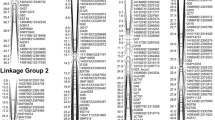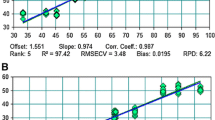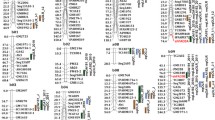Abstract
The quality of canola oil is determined by its constituent fatty acids such as oleic acid (C18:1), linoleic acid (C18:2) and linolenic acid (C18:3). Most canola cultivars normally produce oil with about 55–65% oleic acid and 8–12% linolenic acid. High concentrations of linolenic acid lead to oil instability and off-type flavor, while high levels of oleic acid increase oxidative stability and nutritional value of oil. Therefore, development of canola cultivars with increased oleic acid and reduced linolenic acid is highly desirable for canola oil quality. In this study, we have mapped one locus that has a major effect and one locus that has a minor effect for high oleic acid and two loci that have major effects for low linolenic acid in a doubled haploid population. The major locus for high C18:1 was proven to be the fatty acid desaturase-2 (fad2) gene and it is located on the linkage group N5; the minor locus is located on N1. One major QTL for C18:3 is the fatty acid desaturase-3 gene of the genome C (fad3c) and it is located on N14. The second major QTL resides on N4 and is the fad3a gene of the A genome. We have sequenced genomic clones of the fad2 and fad3c genes amplified from an EMS-induced mutant and a wild-type canola cultivar. A comparison of the mutant and wild-type allele sequences of the fad2 and fad3c genes revealed single nucleotide mutations in each of the genes. Detailed sequence analyses suggested mechanisms by which both the mutations can cause altered fatty acid content. Based on the sequence differences between the mutant and wild-type alleles, two single nucleotide polymorphism (SNP) markers, corresponding to the fad2 and fad3c gene mutations, were developed. These markers will be highly useful for direct selection of desirable fad2 and fad3c alleles during marker-assisted trait introgression and breeding of canola with high oleic and low linolenic acid.







Similar content being viewed by others
References
de Arruda M, Lyamichev VI, Eis PS, Iszczyszyn W, Kwiatkowski RW, Law S, Olson MC, Rasmussen EB (2002) Invader technology for DNA and RNA analysis: principles and applications. Exp Rev Mol Diagn 2:487–96
Auld DL, Heikkinen MK, Erickson DA, Sernyk JL, Romero JE (1992) Rapeseed mutants with reduced levels of polyunsaturated fatty acids and increased levels of oleic acid. Crop Sci 32:657–662
Barret P, Delourme R, Brunet D, Jourdren C, Horvais R, Renard M (1999) Low linolenic acid level in rapeseed can be easily assessed through the detection of two single base substitution in fad3 genes. In: proceeding of the 10th international rapeseed congress, Canberra, Australia, pp 26–29
Brown JWS (1996) Arabidopsis intron mutations and pre-mRNA splicing. Plant J 10:771–780
Canvin DT (1965) Effects of temperatures on the oil content and fatty acid composition of the oils from several oil seed crops. Can J Bot 43:63–69
Chen JL, Beversdorf WD (1990) Fatty acid inheritance in microspore-derived populations of spring rapeseed (Brassica napus L.). Theor Appl Genet 80:465–469
Deng X, Scarth R (1998) Temperature effects on fatty acid composition during development of low linolenic oilseed rape (Brassica napus L.). J Am Oil Chem Soc 75:759–766
Hu J, Quiros C, Arus P, Struss D, Robbelen G (1995) Mapping of a gene determining linolenic acid concentration in rapeseed with DNA-based markers. Theor Appl Genet 90:258–262
Hu J, Li G, Struss D, Quiros CF (1999) SCAR and RAPD markers associated with 18-carbon fatty acids in rapeseed, Brassica napus. Plant Breed 118:145–150
Jourdren C, Barret P, Brunel D, Delourme R, Renard M (1996a) Specific molecular marker of the genes controlling linolenic acid content in rapeseed. Theor Appl Genet 93:512–518
Jourdren C, Barret P, Horvais R, Delourme R, Renard M (1996b) Identification of RAPD markers linked to linolenic acid genes in rapeseed. Euphytica 90:351–357
Kosambi DD (1944) The estimation of map distances from recombination values. Ann Eugen 12:172–175
Lorkovic ZJ, Kirk DAW, Lambermon MHL, Filipowicz W (2000) Pre-mRNA splicing in higher plants. Trends Plant Sci 5:160–167
Lyamichev V, Neri B (2003) Invader assay for SNP genotyping. Methods Mol Biol 212:229–40
McCullough AJ, Lou H, Schuler MA (1993) Factors affecting authentic 5′ splice site selection in plant nuclei. Mol Cell Biol 13:1323–1331
Nishiuchi T, Nishimura M, Arondel V, Iba K (1994) Genomic nucleotide sequence of a gene encoding a microsomal ω-3 fatty acid desaturase from Arabidopsis thaliana. Plant Physiol 105:767–768
Okuley J, Lightner J, Feldmann K, Yadav N, Lark E (1996) Arabidopsis fad2 gene encodes the enzyme that is essential for polyunsaturated lipid synthesis. Plant Cell 6:147–158
Parkin IAP, Sharpe AG, Keith DJ, Lydiate DJ (1995) Identification of the A and C genomes of amphidiploid Brassica napus (oilseed rape). Genome 38:1122–1131
Rajcan I, Kasha KJ, Kott LS, Beversdorf WD (1999) Detection of molecular markers associated with linolenic and erucic acid levels in spring rapeseed (Brassica napus L.). Euphytica 105:173–181
Rakow G (1973) Selektion auf linol- und linolen-saureghalt in rapssamen nach mutagener behand-lung. Z Planzen 69:205–209
Rücker B, Röbbelen G (1996) Impact of low linolenic acid content on seed yield of winter oilseed rape (Brassica napus L.). Plant Breed 115:226–230
Scheffler JA, Sharpe AG, Schmidt H, Sperling P, Parkin IAP, Lühs W, Lydiate DJ, Heinz E (1997) Dasaturase multigene families of Brassica napus arose through genome duplication. Theor Appl Genet 94:583–591
Schierholt A, Becker HC, Ecke W (2000) Mapping a high oleic acid mutation in winter oilseed rape (Brassica napus L.). Theor Appl Genet 101:897–901
Schierholt A, Rücker B, Becker HC (2001) Inheritance of high oleic acid mutations in winter oilseed rape (Brassica napus L.). Crop Sci 41:1444–1449
Simpson CG, McQuade C, Lyon J, Brown JWS (1998) Characterization of exon skipping mutants of the COP1 gene from Arabidopsis. Plant J 15:125–131
Somers DJ, Friesen KRD, Rakow G (1998) Identification of molecular markers associated with linoleic acid desaturation in Brassica napus. Theor Appl Genet 96:897–903
Tanhuanpää P, Schulman A (2002) Mapping of genes affecting linolenic acid content in Brassica rapa ssp. oleifera. Mol Breed 10:51–62
Tanhuanpää P, Vilkki J, Vilkki HJ (1995) Association of a RAPD marker with linolenic acid concentration in the seeded oil of rapeseed (Brassica napus L.). Genome 38:414–416
Tanhuanpää P, Vilkki J, Vilkki HJ (1996) Mapping of a QTL for oleic acid concentration in spring turnip rape (Brassica rapa ssp. oleifera). Theor Appl Genet 92:952–956
Tanhuanpää P, Vilkki J, Vihinen M (1998) Mapping and cloning of FAD2 gene to develop allele-specific PCR for oleic acid in spring turnip rape (Brassica rapa ssp. oleifera). Mol Breed 4:543–550
Thies W (1971) Schnelle und einfache Analysen der Fettsäurezusammensetzung in einzelnen Rapskotyledonen. I. Gaschromatographische und papierchromatographische Methoden. Z Pflanzenzuechtg 65:181–202
Thormann CE, Romero J, Namtet J, OsbornTC (1996) Mapping loci controlling the concentrations of erucic and linolenic acids in seed oil of Brassica napus L. Theor Appl Genet 93:282–286
Udall JA, Quijada PA, Osborn TC (2005) Detection of chromosomal rearrangements derived from homeologous recombination in four mapping populations of Brassica napus L. Genetics 169:967–979
Van Ooijen JW, Voorrips RE (2001) JoinMap® Version 3.0: Software for the calculation of genetic linkage maps. Plant Research International, Wageningen, The Netherlands
Van Ooijen JW, Boer M, Jansen RC, Maliepaard C (2002) MapQTL® 4.0: software for the calculation of QTL positions on genetic maps. Plant Research International, Wageningen, The Netherlands
Vos P, Hogers R, Bleeker M, Reijans M, van de Lee T, Hornes M, Frijters A, Pot J, Pleman J, Kuiper M, Zabeau M (1995) AFLP: a new technique for DNA fingerprinting. Nucleic Acids Res 23:4407–4414
Wu DY, Ugozzoli L, Pal BK, Wallace RB (1989) Allele-specific enzymatic amplification of β-globin genomic DNA for diagnosis of sickle cell anemia. Proc Natl Acad Sci USA 86:2757–2760
Acknowledgment
The authors would like to thank Lizheng Wang for her contribution on AFLP analysis and Koni Patterson for her contribution on the optimization of PCR conditions for the fad3c allele-specific marker. The authors would also like to thank Dr. Raghav Ram for critical review of the manuscript.
Author information
Authors and Affiliations
Corresponding author
Additional information
Communicated by S. J. Knapp
Rights and permissions
About this article
Cite this article
Hu, X., Sullivan-Gilbert, M., Gupta, M. et al. Mapping of the loci controlling oleic and linolenic acid contents and development of fad2 and fad3 allele-specific markers in canola (Brassica napus L.). Theor Appl Genet 113, 497–507 (2006). https://doi.org/10.1007/s00122-006-0315-1
Received:
Accepted:
Published:
Issue Date:
DOI: https://doi.org/10.1007/s00122-006-0315-1




